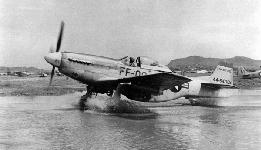
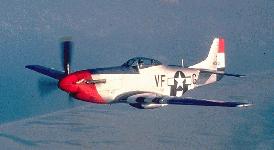
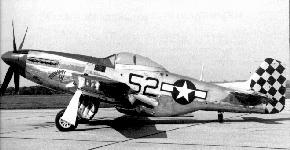
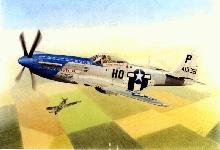
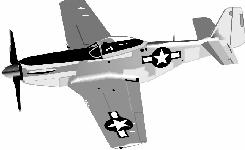




The P-51 Mustang, designed in 1940 after Great Britain requested that North American build P-40 Warhawks for the Royal Air Force, was at first ignored by U. S. officials. However, the design showed such promise that in 1941 the Army Air Forces took delivery of P-51A's powered by the Allison V-1710 engine. These early Mustangs were restricted to reconnaissance and ground attack due to the limited performance of the Allison engines. Tests in 1942 with the Roll-Royce "Merlin" engine showed a marked increase in performance. By the end of 1943, Merlin powered P-51Bs entered combat with the 354th Fighter Group in England. Eighth Air Force Mustangs provided long range escort to B-17s and B-24s and scored heavily over German interceptors. By the war's end, P-51s had destroyed 4,950 enemy aircraft in the air, more than any other U. S. fighter in Europe.
Mustangs served in nearly every active combat zone, including the Pacific where they escorted B-29s from Iwo Jima to Japan. Between 1941 and 1945, the Army Air Force ordered 14,855 Mustangs (including A-36A dive bomber and F-6 photo-reconnaissance versions), of which 7,956 were P-51Ds with the "bubble" canopy and heavier armament. During the Korean Conflict, P-51Ds were used primarily for close support of ground forces until withdrawn from combat in 1953. P-51s served with Reserve and National Guard units until 1957.
Specifications | |
| Wing Span | 37 feet |
| Length | 32 feet, 3 inches |
| Height | 13 feet, 8 inches |
| Weight | 12,100 lbs. maximum |
| Armament | Six .50-caliber machine guns and ten 5-inch rockets or 2,000 lbs. of bombs |
| Engine | Packard built Roll-Royce Merlin V-1650 engine, with 1,695 hp |
| Cost | $54,000 |
| Maximum speed | 437 mph |
| Cruising speed | 275 mph |
| Range | 1,000 miles |
| Service Ceiling | 41,900 feet |




